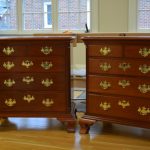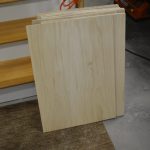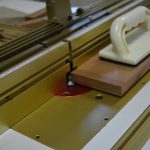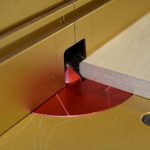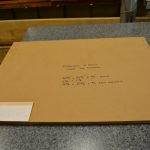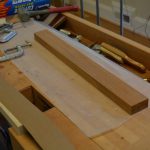After the drawer front milling process has been completed, at LaPlaca WoodWorks we find it easiest to install the hardware on the drawer fronts before the drawers are actually dovetailed.
For this piece we chose to use half mortised drawer locks on the larger bottom three drawers, the locks that we used are Horton Brass LK-4. An important point to remember, on most half mortised locks the center of the lock pin is usually not centered on the lock body, this is case with the locks we used for this piece. Since we needed to install a total of six locks, we chose to make some jigs to make the task easier. Rather than re-inventing the wheel, we modeled the three jigs from an article from Fine Woodworking #145, we needed to make adjustments to account for lipped drawer fronts..
The first jig is used to create the key hole centered on the drawer front, two holes are drilled (1/4″ and 1/8″) using brad point bits..
Next the mortise for the lock plate needs to be milled, I chose to make the lock plate jig a bit on the small side, invariably the plates on brass locks tend to all be slightly different sizes. First I use a marking gauge to establish where I want the bottom of the plate to reside..
After the lock plate jig is attached to the back of the drawer, a small router is used with a top bearing pattern bit.
Here we see the lock body template attached to the back of the drawer (notice how the lock body is offset from the center line of the drawer)
Since this is a deeper mortise we use a full size router and a longer pattern bit to excavate the lock body..
The routing process for the mortise for lock plate and body completed, next the corners for the lock plate and the lock body need to be squared up using a nice sharp chisel. Additionally the mortise for the selvedge (top of the lock plate) needs to done by hand also..
Starting process to mortise the selvedge area
Completed lock mortise..
Finally with the lock installed..
Whew, now that the six locks have been installed, it now time to focus on the Chippendale plate pulls that we sourced from Londonderry Brasses. The pulls are constructed of four piece parts, two posts, the pull handle and finally the plate itself. The drawer fronts need two 1/4″ holes drilled to receive the posts.
The back of the drawer needs a counter bore, this is done since the lock posts are not long enough for the 7/8″ thick drawer fronts. In the 18th century cabinet makers had the same issue, they solved the short post problem by chiseling a mortise around the post, i used a 5/8″ forstner bit to perform the counter bore.
Notice the authentic square brass nuts..
